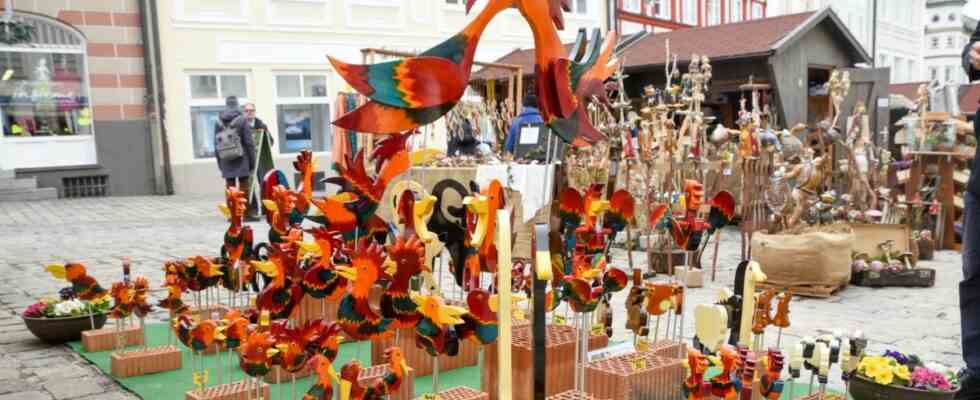Lisa Lösel sits, half hidden behind her handicrafts, in the little wooden house and embroiders. She has no customers at the moment and uses the time to combine leisure and productivity. About ten years ago she was represented with her “sewing workshop” at the Easter market for the first time, three years ago for the last time. Then came Corona, and with it the end for the markets in Bad Tölz. “That hit me very hard, it hit me very hard,” says the Tölzerin. But now she is happy to be back in her little booth again. “It’s a real pleasure to chat with people again.” Even if the routine is a bit missing after the break caused by the pandemic. That was a “real change,” says Lösel.
30 huts are lined up in the pedestrian zone of Tölz, from the vintner monument down to the Marienbrunnen. This time there will be more handicrafts than before, as well as five gastro stands. With the first market since the beginning of the pandemic two years ago, “a bit of normality goes hand in hand,” said Mayor Ingo Mehner (CSU) during a tour on the opening day. The Hüttenstadt is open daily from 11 a.m. to 6 p.m. until April 18, it is only closed on Good Friday. There is also a colorful accompanying program with an Easter bunny hunt in the shop windows in the city centre, an Easter rally and an exhibition “Wuide Henna” by the artist Albert Fiedler in the city museum. Plus lots of music and a fairy tale whisper screen with stories for children (April 9th and 17th).
Mayor Ingo Mehner bought a duck egg with the Mühlfeld Church as a motif at the stand of the artist Janina Wartenberg.
(Photo: Harry Wolfsbauer)
An old regular at the market is Jakob Monn from Wackersberg. He has been there with his sheep and wild skins for 28 years. “It’s really very regional,” says deputy spa director Susann Frey-Allgeier. And Monn is also likely to be one of the few fierantes who welcome the cold spring weather. Then, he freely admits, business will be better for him. Janina Wartenberg has her stand not far away. The artist from Kraków, who lives in Ingolstadt, paints duck, goose and ostrich eggs. “I’m very impressed,” says Mehner and discovers a duck egg with the Mühlfeldkirche as a motif, which he immediately puts back.
Sonja Mückl from Lappersdorf near Regensburg needs almost three days to set up her stand. Sunflowers, birds, rabbits, heads, toadstools as birdhouses – “I make pottery, pottery, pottery,” says the ceramist. Each piece has to be packed individually for transport, and her husband helps with the assembly. “He does the technical stuff.” Sonja Mückl, who is taking part in the Tölz Easter market for the first time, is enthusiastic about the facades of the town houses in the pedestrian zone. “It’s a great atmosphere,” she says.
30 huts, including five gastro stands, are lined up at the Tölz Easter market. It is open daily from 11 a.m. to 6 p.m. until April 18, it is only closed on Good Friday.
(Photo: Harry Wolfsbauer)
The applications for the market are from 2020. “We asked them again and most of them said they would be there again,” reports Frey-Allgaier. And the others? “The question is who survived,” adds Mayor Mehner. “Some don’t exist anymore.” This is not the case for “Claudia’s handbag shop” from Munich. It had its premiere at the Tölz Easter Market in 2019. Now people are “very, very happy” to be back,” says Christian Sicheneder. In his hut he offers felt and traditional costume articles that deaf young people in vocational rehabilitation made for people with hearing impairments. Where he found the Corona Has it survived the period economically? He switched to the online business, which “went well,” says Sicheneder. “And now we have a combination of both here: look and order online.”

